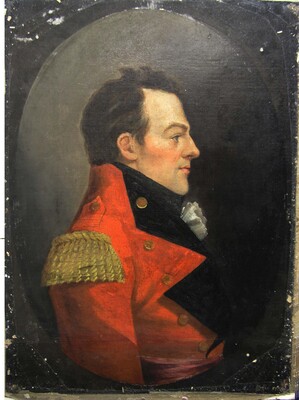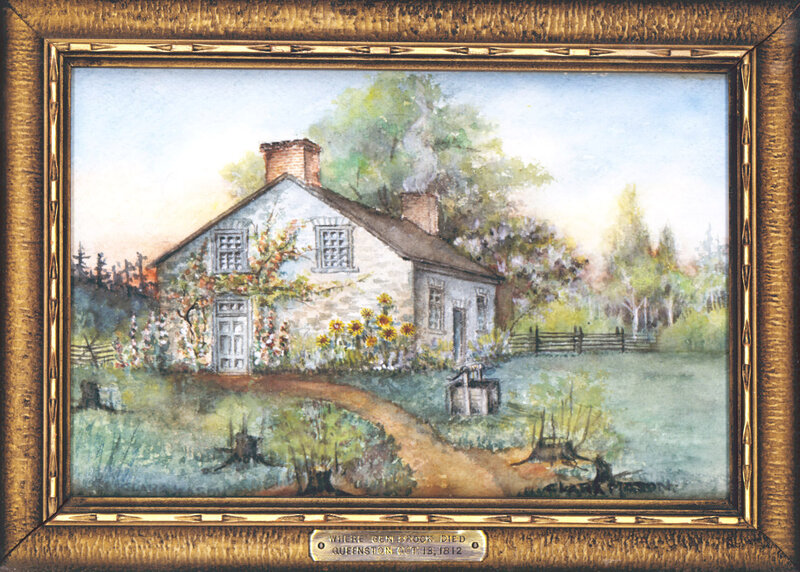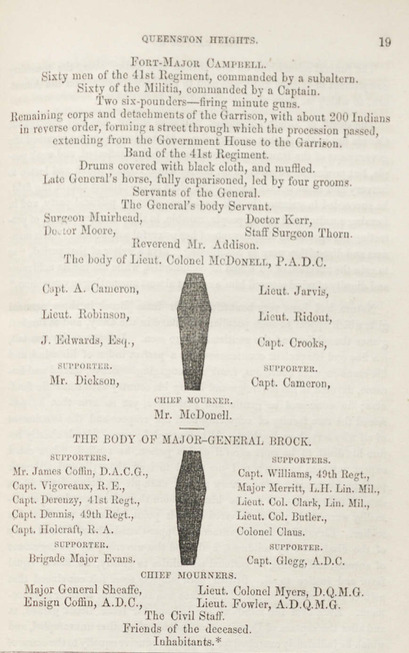Death of Brock
The Battle of Queenston Heights
Sir Isaac Brock was born in 1769 in Guernsey among the Channel Islands. He was just 43 years old when he met his death at Queenston Heights on October 13, 1812. During that night, General Stephen Van Rensselaer and 3,000 of his men journeyed across the Niagara River from Lewiston, New York and stormed the town of Queenston. A small group of British soldiers had defended Queenston, but Van Rensselaer's troops took over Queenston Heights and captured the redan battery. This was a large cannon that was aimed at Lewiston, N. Y. The Americans repositioned the cannon so that it was facing Queenston.
General Brock had been at Fort George when he heard the guns firing and rushed to the battle. He gathered the British troops who were at the bottom of the hill and led them upward toward the Americans. Brock and his men were pushed back. He mounted another attack against the enemy. As a tall man, brandishing a sword, he was an easy target in his red uniform and cocked hat. Musket balls flew around him and a bullet grazed his wrist. He ignored this and as he stepped forward, a sharpshooter put a musket ball through his right breast. The ball went completely through his body.
This is where the story becomes murky. Some say that he turned to shout "Push on the brave York Volunteers." He may have said this at some point, but modern forensics point to the fact that he was killed instantly and didn't say a word. George Stephen Benjamin Jarvis was beside him and he attested to the fact that he died instantly. Brock was carried downhill and his body was hidden under a pile of blankets. Other interpretations of his last words include: "push on" or "push on, my boys, never mind me." Another version of this story claims that Captain John Glegg said that Brock's words were "my fall must not be noticed or impede my brave companions from advancing to victory." History is fraught with myth and legend.
Brock's Aide-de-camp John Macdonnell was left to lead the troops, but he was wounded and trampled by his horse. He succumbed to his wounds shortly after midnight. Brock's body was placed in a house in Queenston. Brock had sent for reinforcements to Major General Sheaffe at Fort George, but Brock did not wait for Sheaffe's arrival. When General Sheaffe arrived from Fort George with troops, he defeated the invaders and took almost 1,000 prisoners.
The House Where Brock's Body was Laid
Brock's body was taken to a stone house that belonged to Patrick McCabe. This house was located near the Laura Secord homestead. Today, the location would be listed as the corner of Queenston and Partition Streets. The house stood for over a century but was torn down in the 1920s. A marker has been placed where the house once stood.
The First Burial of Brock and Macdonell
The body of Sir Isaac Brock lay in state in a Government House for three days. Aide-de-camp John Glegg was in charge of the funeral arrangements. He was aware of Brock's aversion to ostentatious displays, but people from all over the province wished to pay their respects. Brock and Macdonell were buried at ten o'clock in the morning of October 16, 1812. They were buried with military honours at Fort George in the northeast corner of the Cavalier's Bastion. They remained there for twelve years. The area where their bodies were laid is now known as Brock's Bastion.




